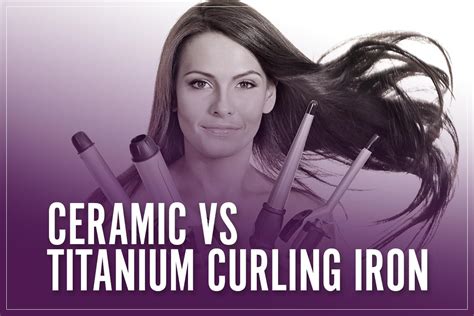Your curling iron is one of the most important tools in your hair care arsenal. It can help you create beautiful, bouncy curls that will turn heads. But with so many different curling irons on the market, it can be hard to know which one is right for you.

One of the most important factors to consider when choosing a curling iron is the material of the barrel. The barrel is the part of the iron that comes into contact with your hair, so it’s important to choose a material that will heat evenly and won’t damage your hair.
Here are the pros and cons of the three most common curling iron barrel materials:
Ceramic
- Pros: Ceramic barrels heat evenly and distribute heat well, which helps to prevent hot spots that can damage your hair. Ceramic is also a good choice for people with fine or damaged hair, as it is less likely to cause breakage.
- Cons: Ceramic barrels can be more expensive than other types of barrels.
Titanium
- Pros: Titanium barrels heat up quickly and evenly, and they can reach higher temperatures than ceramic barrels. This makes them a good choice for people with thick or coarse hair, as they can create tighter curls. Titanium barrels are also very durable.
- Cons: Titanium barrels can be more expensive than other types of barrels, and they can be more difficult to find.
Tourmaline
- Pros: Tourmaline barrels emit negative ions, which help to reduce frizz and add shine to your hair. Tourmaline is also a good choice for people with sensitive skin, as it is less likely to cause irritation.
- Cons: Tourmaline barrels can be more expensive than other types of barrels.
Ultimately, the best material for a curling iron depends on your individual hair type and needs. If you have fine or damaged hair, a ceramic barrel is a good choice. If you have thick or coarse hair, a titanium barrel is a better option. And if you want to reduce frizz and add shine to your hair, a tourmaline barrel is a great choice.
In addition to the barrel material, there are several other factors to consider when choosing a curling iron, including:
- Barrel size: The size of the barrel will determine the size of your curls. Smaller barrels create tighter curls, while larger barrels create looser curls.
- Temperature settings: The temperature settings on your curling iron will allow you to customize the heat to your hair type. Lower temperatures are better for fine or damaged hair, while higher temperatures are better for thick or coarse hair.
- Features: Some curling irons come with additional features, such as a digital display, a rotating barrel, or a cool tip. These features can make curling your hair easier and more convenient.
Q: What is the best way to curl my hair with a curling iron?
A: To curl your hair with a curling iron, start by sectioning your hair into small, manageable pieces. Then, wrap each section of hair around the barrel of the curling iron and hold it for a few seconds. The length of time you hold the iron will determine the tightness of your curls.
Q: How often should I curl my hair?
A: How often you curl your hair depends on your hair type and how much damage you are willing to do to your hair. If you have fine or damaged hair, you should curl it less often to avoid breakage. If you have thick or coarse hair, you can curl it more often.
Q: Can I curl my hair every day?
A: Curling your hair every day is not recommended, as it can damage your hair. If you want to curl your hair every day, be sure to use a heat protectant spray to minimize the damage.
Q: What is the best way to protect my hair from heat damage?
A: To protect your hair from heat damage, use a heat protectant spray before you curl your hair. You should also avoid using high heat settings on your curling iron.
